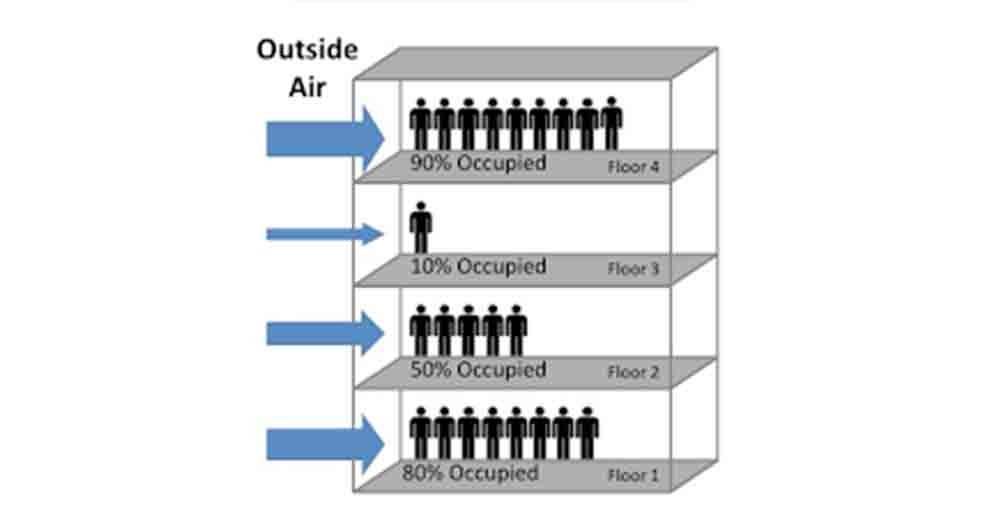Real-time IAQ monitoring empowers smart and energy-efficient ventilation
Now, more than ever, Indoor Air Quality (IAQ) management is crucial for creating a safe, healthy space for living and working. Real-time IAQ monitoring can ensure a safe and comfortable indoor environment for the building occupants, but it goes beyond that. While maintaining desirable indoor air, real-time IAQ monitoring can also help adjust the ventilation rate according to the real-time occupancy and help save energy.
The more effective your building's ventilation is, the better the air quality it has.
HVAC, short for Heating, Ventilation and Air-Conditioning, is a system that helps maintain good IAQ of a building and maximize the comfort of occupants. It improves air quality by regulating the heat, airflow, ventilation, and air conditioning of a building.
HVAC systems operate on a simple principle. A thermostat serves as the brain of an HVAC system. It monitors the indoor temperature and automatically triggers your HVAC system to start circulating air when it gets higher or lower than the present temperature. Through adequate ventilation, the HVAC system can help control pollutant levels, odours, temperature, humidity and other factors that can affect the health and comfort of building occupants.
Ventilation standards are a great way to guarantee IAQ; however, it's not a one-size-fits-all situation.
To ensure adequate indoor air quality, organizations like ASHRAE (The American Society of Heating, Refrigerating and Air-Conditioning Engineers) released ANSI/ASHRAE Standards 62.1 and 62.2 as standards for ventilation system design, in which they specify minimum ventilation rates.
The guidelines recommend ventilation rates for indoor spaces such as schools, offices, shops and restaurants to be from 0.35 to 8 air changes per hour, with the exact air exchange rates based on the size of a room, its use, and the occupancy rates. However, the real-time occupancy of these facilities is constantly changing; hence, the real ventilation needs are constantly changing accordingly. So, setting the ventilation standards with a minimum ventilation rate is not always the solution to achieve the most effective ventilation.
For example, in a cinema, depending on whether the movie showing is a hit or a flop, playing during a matinee or premiere night, the number of the moviegoers varies, which will result in the difference of required ventilation rates. The same goes for schools and other commercial buildings. Classrooms aren't always occupied, and with flexible work becoming the norm, the occupancy of the office is always changing and sometimes even significantly reduced, which allows the ventilation to be reduced considerably, resulting in substantial energy savings.
This is where real-time IAQ monitoring empowered DCV comes in and saves energy.
Ventilate the space only when needed.
Demand controlled ventilation (DCV) is an energy-saving control strategy. It regulates the ventilation rate based on real-time occupancy monitoring, often reflected by carbon dioxide concentration through a CO2 sensor. With the occupancy levels being monitored in real-time, DCV empowers buildings to save energy by minimizing ventilation rates while guaranteeing desired IAQ.
Besides, with real-time monitoring, the building manager can also spot failure of the HVAC system in a building and facilitate in-time maintenance, optimizing building performance and boosting wellness. And if we go a little further by adding differential pressure monitoring in the HVAC system, we can also make the change of the filters stress-free and prolong the life span of an HVAC system.
Real-time IAQ monitoring on saving energy cost
According to a case study published in the International Journal of Ventilation in 2019, the DCV-system saves energy used for heating the supply-air by 86% compared to a mechanically balanced ventilation system without heat recovery, and 22% in comparison to the same system but with heat recovery.
Another Study shows that DCV systems can save from $0.05 to $1.00 per square foot depending on the occupancy schedule and climate. A recent survey on Norwegian schools also found that using CO2 sensors for DCV (instead of constant air volume ventilation) reduced energy consumption by 62%.
Through minimizing ventilation rates, IAQ real-time monitoring can significantly reduce energy usage while maintaining healthy air quality conditions in the building. Not only does this energy usage reduction mean lower energy bills, but the environmental impact of the building is likewise reduced.





